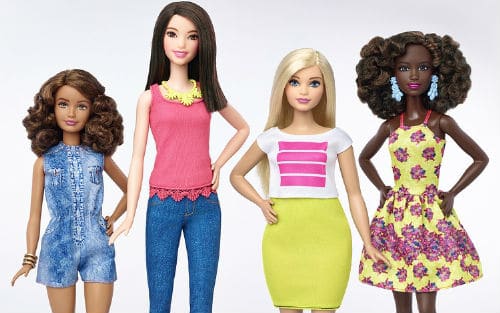
It's official - Barbie's thigh gap is gone.
On Thursday, Mattel announced that new versions of Barbie - tall, petite and curvy - will soon ship to stores. These new versions will also come in different skin tones with a bunch of different hair styles. The new body shapes are a step away from the traditionally ultra-thin version of the doll.
Mattel has been marketing new versions of Barbies over the last few years. Last year, for example, the company introduced 23 new Barbie dolls with a variety of hairstyles and outfits, USA Today reported.
But these new curvy, petite and tall versions of the toy aim to help girls better understand the world around them - and appeal to parents.
"We believe we have a responsibility to girls and parents to reflect a broader view of beauty," said Evelyn Mazzocco, senior vice president and global general manager of Barbie, in a company statement.
Time magazine's Eliana Dockterman got an exclusive first look at the new dolls and found that they match what many parents want for their children's Barbie dolls, at least according to previous research done by Mattel.
Moms wanted the new dolls to have different body types above all else, Dockterman reported. They also wanted less makeup, some modest clothing and the ability for the doll to be mobile so it can be used to play sports. Wholesome dolls were also a big priority for parents, which isn't surprising since sexual pervasiveness in society is a major concern for parents today. All of these requirements were met.
But some of the moms still had complaints about the new dolls, especially the one labeled "petite." Moms felt this put an added pressure on young girls to obtain this body form since it's skinnier than the original version of the Barbie.
"Mothers across America care deeply about what sort of beauty standards their daughters are exposed to - and all were supportive of Barbie's new direction, though some thought the curvy doll should be even curvier," she wrote.
Regardless of the specifics, these dolls have given moms different options when choosing a new Barbie doll for their child - options that offer a chance to spread positive messages about body acceptance and diversity.
This may be the way of the future for Mattel, as these Barbies are just the first time the toy company has specifically designed dolls based on the wants and needs of parents, not children.
As Aisha Sultan wrote for the St. Louis Post-Dispatch, these new Barbies are Mattel's way of reaching mothers who previously spoke out against the doll's body type and the social pressures it put on young girls.
But it won't necessarily work as a marketing strategy. Sultan said young girls are still likely to suffer body image issues regardless of what the dolls are like since they still promote fashion and beauty above all else.
Parents, in addition to opening their child's eyes to more realistic Barbies, should look to teach lessons about how to properly understand body image so their children can avoid those issues, Sultan wrote.
"It's also about the other media a child consumes, the conversations you have at home, the role models she admires," Sultan wrote. "While Barbie's new sizes may not matter so much to the child playing with her, Mattel is banking on the fact that grown-ups will notice."

